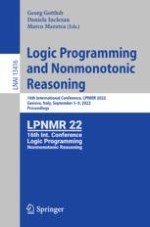2022 | Buch
Logic Programming and Nonmonotonic Reasoning
16th International Conference, LPNMR 2022, Genova, Italy, September 5–9, 2022, Proceedings
herausgegeben von: Georg Gottlob, Daniela Inclezan, Marco Maratea
Verlag: Springer International Publishing
Buchreihe : Lecture Notes in Computer Science
